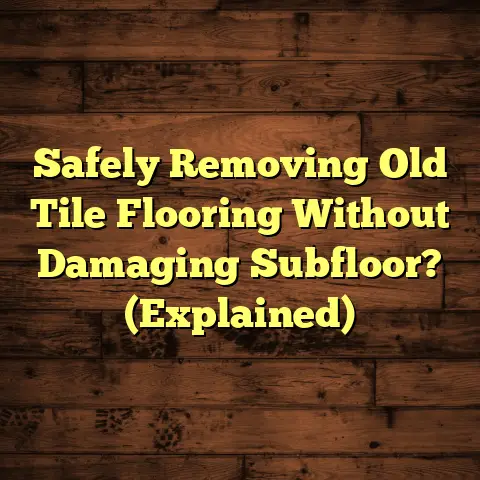Hardwood Thickness (Find *Your* Perfect Fit!)
Flooring, right? It’s not just something you walk on. It’s the foundation of your home’s style, its comfort, and honestly, a big reflection of you.
I’ve been in the flooring game for years, and I’ve seen it all – from families with toddlers turning living rooms into obstacle courses, to pet owners battling the never-ending war against scratches.
And let me tell you, choosing the right hardwood flooring is about way more than just picking a pretty color.
It’s about finding the perfect balance between aesthetics, durability, and how well it fits into your life.
That’s where hardwood thickness comes in.
Think of it as the secret ingredient that can make or break your flooring experience.
Too thin, and you might end up with dents and dings. Too thick, and you might be overspending.
So, how do you find that sweet spot?
Well, grab a cup of coffee (or tea, I don’t judge!), and let’s dive into everything you need to know to choose the right hardwood thickness for your home and lifestyle.
I promise, it’ll be worth it!
Section 1: Understanding Hardwood Thickness
Okay, let’s get down to brass tacks.
What exactly is hardwood thickness?
Simply put, it’s the measurement of how thick the wood plank is, usually expressed in inches or millimeters.
You’ll typically see standard measurements like 3/4 inch, 5/8 inch, or 1/2 inch.
But what do those numbers actually mean?
Well, it all boils down to the type of hardwood flooring you’re considering: solid or engineered.
-
Solid Hardwood: This is the real deal – a single piece of wood milled from a tree. Because it’s solid, the thickness is literally the distance from the top of the board to the bottom.
Think classic, durable, and able to be refinished multiple times. * Engineered Hardwood: This is where things get a little more interesting. Engineered hardwood is made up of layers. A thin veneer of real hardwood is bonded to a core of plywood or high-density fiberboard (HDF).
The overall thickness is the measurement of all those layers combined. The wear layer is the actual hardwood layer.
And that’s what really determines how many times you can refinish it.
The construction method and the materials used will determine the thickness.
Solid hardwood is limited by the size of the tree it comes from.
Engineered hardwood can be manufactured in a wider range of thicknesses and widths.
Now, let’s talk about the relationship between thickness and some important factors:
- Durability: Generally speaking, thicker hardwood is more durable. It can withstand more wear and tear, and is less likely to dent or scratch.
- Longevity: A thicker wear layer (in engineered hardwood) or a thicker plank (in solid hardwood) means more opportunities to refinish the floor down the road, extending its lifespan.
- Maintenance: Thicker floors are often more forgiving when it comes to maintenance. They can handle more aggressive cleaning methods if needed, and are less prone to damage from moisture.
Here’s a handy little table to illustrate the differences:
| Feature | Solid Hardwood | Engineered Hardwood |
|---|---|---|
| Construction | Single piece of wood | Multiple layers bonded together |
| Thickness Range | Typically 3/4 inch or thicker | Varies, commonly 1/2 inch to 3/4 inch |
| Durability | Excellent | Good to Excellent (depends on wear layer) |
| Refinishing | Multiple times | Limited by wear layer thickness |
| Moisture Resistance | Less resistant | More resistant (due to plywood core in some cases) |
Make sense?
Great! Now that we’ve got the basics down, let’s move on to the fun part: figuring out how your lifestyle plays into all of this!
Section 2: Lifestyle Needs and Hardwood Thickness
Alright, let’s get personal.
Think about your day-to-day life.
How do you really use your home?
Do you have a house full of kids running around?
Are you a pet parent to a furry friend (or two… or three)?
Do you love hosting dinner parties and dancing the night away?
These are the questions that will guide you to the perfect hardwood thickness.
Let’s break it down by lifestyle:
-
Families with Young Children: Let’s face it, kids are adorable little tornadoes. Durability is key. You’ll want a thicker hardwood (think 3/4 inch solid or engineered with a thick wear layer) that can withstand dropped toys, spills, and the occasional “artwork” created with crayons on the floor. Safety is also important. Look for options with a low-VOC finish and consider adding rugs in high-traffic areas to cushion falls. Ease of cleaning is another must. A smooth finish that’s easy to wipe down will be your best friend.
-
Pet Owners: Ah, the joys of pet ownership! But those claws and accidents can wreak havoc on your floors. Scratch resistance is paramount. Opt for a harder wood species (like hickory or maple) and a durable finish. Moisture protection is also crucial, especially if you have a pup who’s prone to accidents. Engineered hardwood with a moisture-resistant core can be a lifesaver. I’ve seen a lot of clients go with distressed looks because the scratches blend in easily.
-
Active Households: If you’re always on the go, your floors need to keep up. Wear resistance is essential. Look for hardwood with a high Janka rating (a measure of wood hardness). Sound insulation can also be a factor, especially if you live in an apartment or have multiple stories. Thicker flooring can help dampen noise.
Janka Rating? The Janka hardness test measures the resistance of a sample of wood to denting and wear. It’s one of the best measures of the ability of a wood species to withstand denting and wear. The higher the number, the harder the wood. https://www.wood-database.com/janka-hardness/
-
Minimalist or Modern Aesthetics: If you’re drawn to clean lines and a sleek, uncluttered look, you might prefer thinner hardwood profiles. They can create a more streamlined appearance and work well in contemporary spaces.
Here are some examples of how different thicknesses can meet these lifestyle needs:
- A family with young children might choose 3/4 inch solid hickory with a durable polyurethane finish.
- A pet owner might opt for engineered maple with a thick wear layer and a waterproof core.
- An active household might go for 5/8 inch solid oak with a high Janka rating and a sound-dampening underlayment.
- A minimalist might select 1/2 inch engineered birch with a matte finish.
And don’t forget to think about the future!
Will your family be growing?
Are you planning to age in place?
These are important considerations that can influence your flooring choices.
For example, if you’re planning to stay in your home for the long haul, investing in thicker, more durable hardwood can be a smart move.
It’ll last longer and require less maintenance over time.
Section 3: Benefits of Thicker Hardwood Flooring
Okay, let’s sing the praises of thicker hardwood!
Why should you consider going big?
Well, here are a few compelling reasons:
- Enhanced Durability: This is the big one. Thicker hardwood can withstand a lot more abuse than thinner options. It’s less likely to dent, scratch, or show wear and tear. If you have kids, pets, or a high-traffic home, this is a major plus.
- Improved Sound Insulation: Thicker flooring acts as a natural sound barrier, dampening noise from footsteps, music, and other activities. This can be a game-changer if you live in an apartment or have multiple stories.
- Comfort Underfoot: There’s just something about the feel of a solid, substantial floor beneath your feet. Thicker hardwood provides a more solid and comfortable walking surface.
- Greater Potential for Refinishing: As I mentioned earlier, a thicker wear layer (in engineered hardwood) or a thicker plank (in solid hardwood) means more opportunities to refinish the floor down the road. This can significantly extend the life of your floor and keep it looking beautiful for years to come.
- Added Home Value: In general, thicker, higher-quality hardwood flooring can add value to your home. It’s seen as a premium feature that can attract buyers and increase your property’s resale value.
I’ve had clients tell me stories about how their thicker hardwood floors have stood the test of time, even with rambunctious kids and pets.
One client, Sarah, told me that she initially hesitated about spending the extra money on 3/4 inch solid hickory, but after years of spills, dropped toys, and muddy paws, she’s so glad she did.
Her floors still look amazing, and she knows she can refinish them down the road if needed.
Another client, Mark, opted for thicker engineered hardwood with a sound-dampening underlayment in his condo.
He said it made a huge difference in reducing noise from his upstairs neighbors.
Thicker flooring can be a significant investment, but it’s one that can pay off in the long run, both in terms of durability and home value.
Section 4: Benefits of Thinner Hardwood Flooring
Now, let’s not forget about the advantages of thinner hardwood!
While thicker flooring has its perks, thinner options can be a great choice in certain situations.
Here’s why:
- Lightweight and Easier to Install: Thinner planks are generally lighter and easier to handle, making them a good option for DIY projects. If you’re a seasoned DIYer, you might be able to save some money by installing thinner hardwood yourself.
- Cost Savings: Thinner hardwood is typically less expensive than thicker options, both in terms of materials and installation costs. If you’re on a tight budget, this can be a significant factor.
- Aesthetic Versatility: Thinner profiles can create a more streamlined and modern look. They can also be a good choice if you’re trying to match the height of existing flooring in adjacent rooms.
- Suitable for Multi-Layer Installations: Thinner hardwood is often used in multi-layer installations, where it’s installed over an existing subfloor or even another type of flooring. This can be a cost-effective way to update your floors without having to tear out the old ones.
- Works well with Radiant Heating: Thinner flooring transfers heat more efficiently than thick flooring.
I’ve seen designers use thinner hardwood to create some really stunning and unique looks.
For example, one designer used 1/4 inch bamboo flooring to create a geometric pattern on a wall.
It looked amazing!
Another contractor told me that he often recommends thinner engineered hardwood for basements because it’s more resistant to moisture than solid hardwood.
Here’s a real-world example.
I worked with a client who wanted hardwood in her upstairs hallway, but the subfloor was slightly uneven.
Installing a thick hardwood floor would have required a lot of extra prep work to level the subfloor.
Instead, we opted for a thinner engineered hardwood that could be easily installed over the existing subfloor with a self-leveling compound.
It saved her a lot of time and money, and the finished result looked fantastic.
Section 5: Making the Right Choice for Your Home
Okay, you’ve got all the information.
Now it’s time to make a decision!
How do you choose the right hardwood thickness for your home?
Here’s a step-by-step guide:
- Assess Your Lifestyle: Start by thinking about your lifestyle. Do you have kids? Pets? A high-traffic home? Are you planning to stay in your home for the long haul?
- Consider Your Budget: How much are you willing to spend on flooring? Thicker hardwood is generally more expensive than thinner options.
- Evaluate Your Home Environment: What’s the climate like in your area? Is your home prone to moisture? Do you have any existing flooring that you need to match?
- Think About Aesthetics: What kind of look are you going for? Do you prefer a classic, traditional style or a more modern, minimalist aesthetic?
- Consult with a Professional: Talk to a flooring contractor or designer. They can help you assess your needs, recommend the right type of hardwood, and provide expert installation.
Here are some questions to ask yourself:
- “Do I need maximum durability, or is a more budget-friendly option okay?”
- “Is sound insulation important to me?”
- “Am I comfortable with DIY installation, or do I prefer to hire a professional?”
- “What kind of maintenance am I willing to do?”
And here’s how to weigh the pros and cons of different thickness options:
| Feature | Thicker Hardwood | Thinner Hardwood |
|---|---|---|
| Pros | Enhanced durability, improved sound insulation, greater potential for refinishing, added home value | Lightweight, easier to install, cost savings, aesthetic versatility |
| Cons | More expensive, heavier, requires more prep work | Less durable, limited refinishing potential |
Remember, there’s no one-size-fits-all answer.
The best hardwood thickness for your home will depend on your unique circumstances and preferences.
And don’t be afraid to ask for help!
A good flooring professional can guide you through the process and help you make the right choice.
They can also help you understand local climate considerations and installation techniques.
For example, in areas with high humidity, engineered hardwood is often a better choice than solid hardwood because it’s less prone to warping.
Conclusion
So, there you have it!
Everything you need to know to find the perfect hardwood thickness for your home.
I hope this article has been helpful and informative.
Choosing the right flooring is a big decision, but it’s also an exciting opportunity to create a space that you love.
Take your time, do your research, and don’t be afraid to ask questions.
Remember, the right choice will not only enhance your home’s aesthetic but also support your daily activities and overall well-being.
So go ahead, create a space that truly reflects your unique lifestyle through the right flooring choice.
I’m confident that you’ll find the perfect fit for your home and your life!





